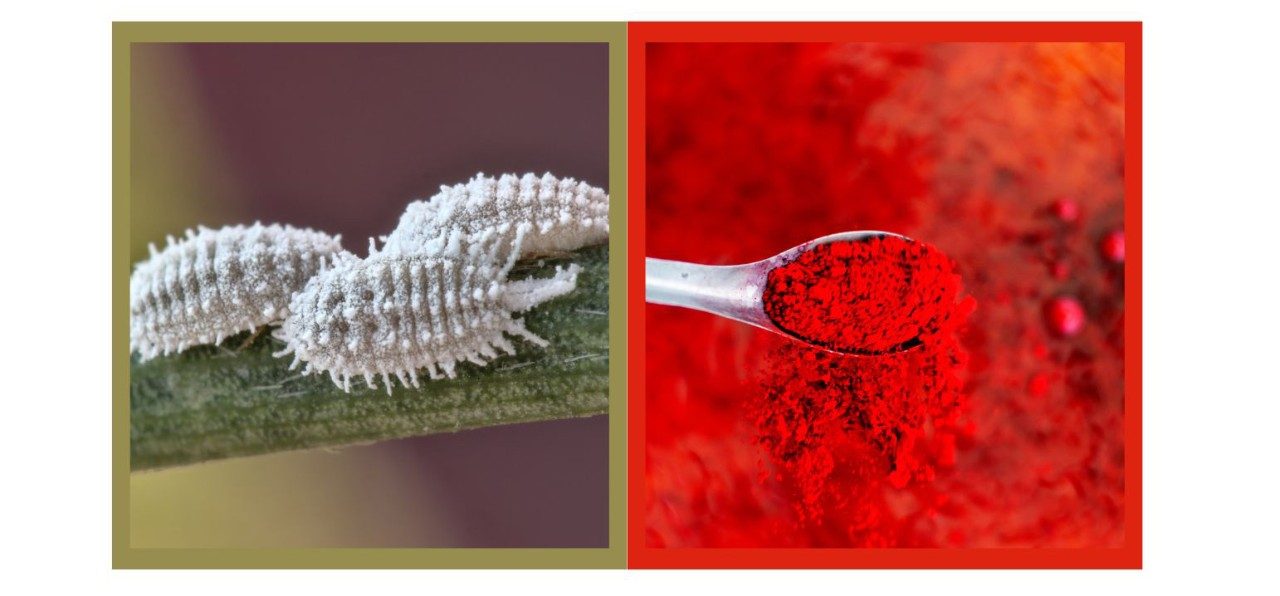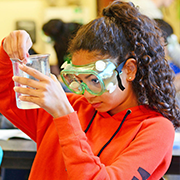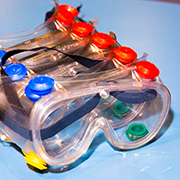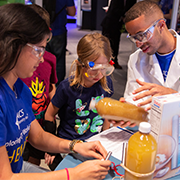Nature of Dye
Ages
5 - 13 years
Activity Time
Preparation: 5 mins
Activity: 5 - 20 mins (hands-on), 30 - 60 mins (total)
Group Size
* Participants work in pairs/trios
* Younger participants: 1 facilitator per two groups
* Older participants: 1 facilitator per 5 groups
ACS Student Chapter at North Central College Presents: Nature of Dye
- Natural vs. synthetic compounds: Chemicals can be synthesized in a lab or found in nature.
- Pigments: Cochineal bugs contain carminic acid, a common natural dye.
- Indicators: Carminic acid is an acid-base indicator that turns from orange-red to burgundy or purple in basic solution.
- Protect work surfaces from staining, or work outside
- Potential hazards include:
- Acids and bases
- Flammables
- Spills and splashes
- Conduct your own RAMP assessment prior to presenting the activity.
Each group should be provided:
- Metal spoon and bowl, mortar and pestle, or other materials to crush cochineal bugs
- 7 small cups or beakers
- Markers for labeling cups or beakers
- Disposable dropper pipets or medicine droppers
- Thick paper (e.g. cardstock, watercolor paper)
- 2-3 paint brushes
- 0.5 cup water
- ~1 tablespoon vinegar
- ~0.5 teaspoon baking soda or sodium carbonate
- 2 pieces dried cochineal bugs (Available on Amazon or natural craft supply stores)
- Any additional materials identified in your RAMP analysis
Prior to Activity
Customize Activity to Venue
- Review RAMP safety worksheet.
- Adapt procedure to your venue and participants.
- List appropriate procedures for accidents, emergencies.
Identify Safety Practices
- Wear personal protective equipment (goggles, gloves, etc.).
- Secure loose hair, clothing.
- Prohibit eating, drinking.
- Clean work area, wash hands after activity.
- Additional practices identified in RAMP worksheet.
Prepare Materials
- Collect materials
- For each group, label 2 cups “water,” another 2 “vinegar,” another 2 “baking soda," and the final one “rinse.”
On-Site
For each group:
- Place the vinegar in one of the vinegar cups; set an empty vinegar cup next to it.
- Mix baking soda and 1 tsp water in one of the baking soda cups; set an empty baking soda cup next to it.
- Place ~1 tablespoon water in one of the water cups; set an empty water cup next to it.
4. Place the remainder of the water in the “rinse” cup.
5. Arrange the bowl and spoon (or mortar and pestle), paper, paintbrushes, and dried cochineal bugs near the cups.
-
Introduce Activity
Instructions
Explain:
- Chemicals can be either man-made or found in nature.
- Participants will create their own color-changing dye using a natural source (bugs!)
Talking Points
- Where do you see dyes used?
-
Prepare the Dye
Instructions
Direct participants to:
- Crush the bug into a fine powder using the pestle (or the back of a metal spoon).
- Add several drops of water to the mortar (or bowl) and mix the solution using the pestle (or spoon) to make a slurry.
Talking Points
- What does the powder look like?
- What color is the slurry?
-
Change the Color of the Dye
Instructions
Direct participants to:
- Transfer equal amounts of slurry to the empty cups labeled “water,” “vinegar,” and “baking soda”. Use a pipet/dropper to add 1-2 drops of water to the cochineal slurry in the “water” cup.
- Use a separate pipet/dropper to add 1-2 drops of vinegar to the slurry in the “vinegar” cup.
- Use a separate pipet/dropper to add 1-2 drops of baking soda to slurry in the “baking soda” cup.
Talking Points
- What happens when you mix the slurry with vinegar? With baking soda?
- Is the change more dramatic if you add more vinegar?
- Why do you think the slurry changes to one color for vinegar and another for baking soda?
-
Use Dye to Paint a Picture
Instructions
Explain how the bugs contain carminic acid, its acid/base indicator properties, and its use as a dye. (See Explore the Chemistry)
Direct participants to:
- Use the slurries, paintbrushes, and paper to paint your own picture.
Talking Points
- How else can you use the slurries? What happens if you soak pieces of fabric, like cotton, wool, or polyester, in them?
- What other acids or bases could you use (lemon juice, carbonated soft drinks, cream of tartar, window cleaner)?
-
Clean Up
Instructions
- Dispose of all solids in the trash.
- Pour all remaining liquids down the drain.
- Wipe all work surfaces clean with water, or a damp cloth.
- Wash hands thoroughly.
Here are some key themes to explore with the audience once they've completed the activity. Adjust the details to match the level of your audience.
You made your own colorful dye out of crushed bugs and water!
The cochineal (koh-chin-eel) bug (Dactylopius coccus) is a scale insect that lives on cactuses in the Southwestern United States and South America.
The shell of the female cochineal contains a vibrant red chemical called carminic acid. Carminic acid's color is pH-dependent. For a more orange-red, you can lower the pH (make it more acidic). To create a darker wine red or violet, you need to increase the pH (make it more basic).
Indigenous people in Central and South America, including the Incas and Aztecs, were the first to discover ways to use cochineal bugs to make pigments that could color fabrics and other materials. This dye was once so highly prized that bags of the dried bugs were used as currency or as tribute.
Spaniards, who colonized these areas, took the cochineal process back to Europe. Cochineal is one of the few natural water-soluble dyes to not degrade with time. Europe had no red dyes that could compare for vividness and endurance, and for a time cochineal was Mexico’s second-most valuable export after silver.
Cochineal was used to dye the cloaks of Roman Catholic cardinals and to color jackets that gave British "redcoat" soldiers their nickname.
Today, cochineals are still a natural source of dye for fabrics, make-up, and food products around the world. While generally considered safe, they may trigger allergic reactions in some people, and people with certain dietary restrictions do need to avoid products using cochineals. Additionally, extracting the dye can be expensive and labor-intensive, compared to synthetic dyes.
References
- American Chemical Society, 2023
- ACS Student Chapter at North Central College
- This activity is a modification of the Nature of Dye activity from the Explore Science: Let’s Do Chemistry activity from the NISE Network. https://www.nisenet.org/catalog/nature-dye (accessed September 2023)





